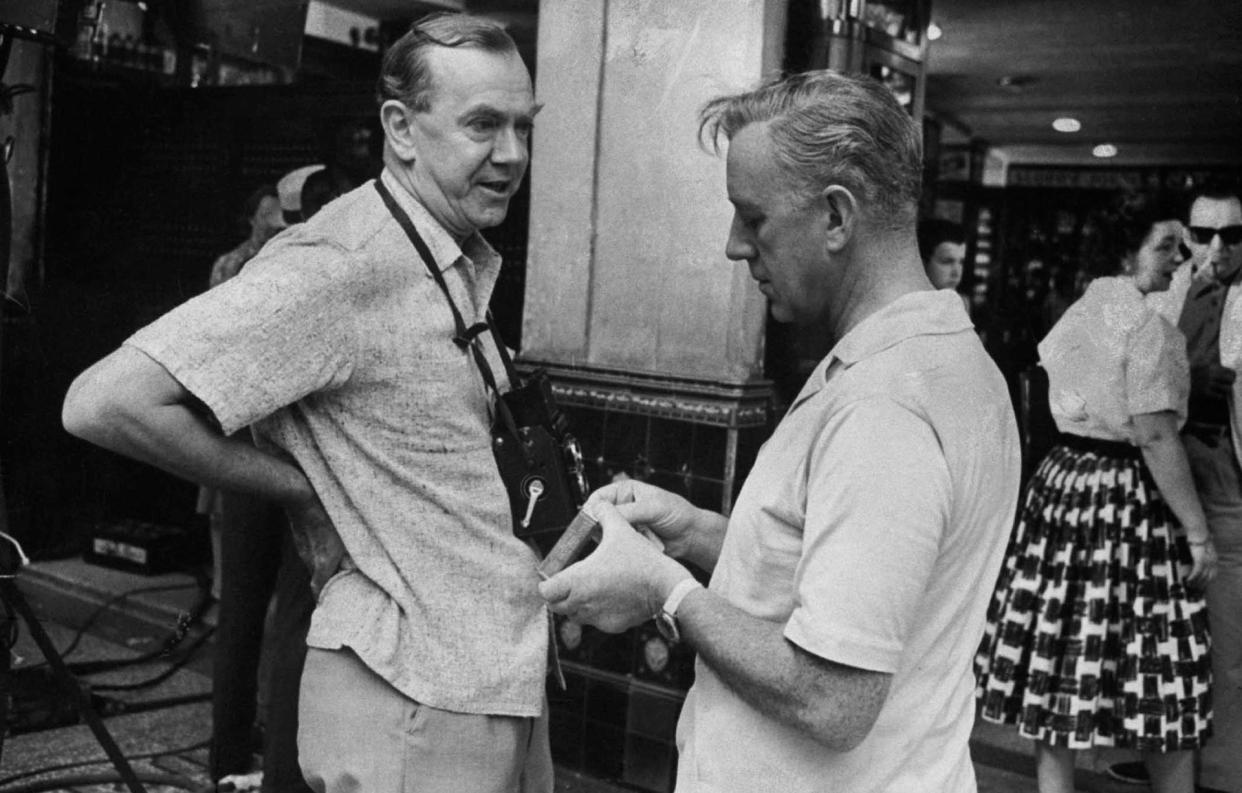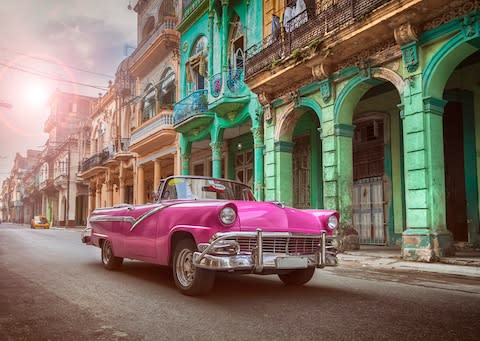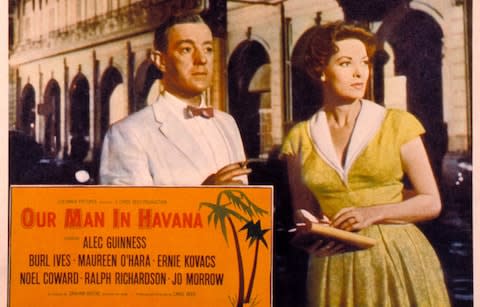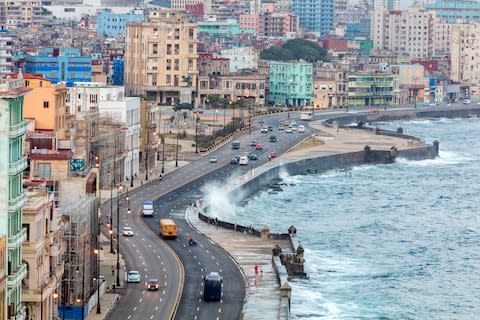How to discover the thrilling side of Havana that inspired Graham Greene

Hemingway remains a legend here, but Graham Greene loved it just as much, says Claire Boobbyer
The music swells as red-aproned bartenders mix and muddle behind the long counter of El Floridita. Lining up on the bar, the cocktail count measures up like this: 20 daiquiris and one martini.
In translation: a score of rum-and-lime cocktails drunk by travellers in honour of Ernest Hemingway’s 16-daiquiri record at the renowned Havana bar, versus one of Graham Greene’s regular vodka tipples. Mine is the vodka.
Hemingway’s hard-drinking love affair with Havana has become legendary; yet Graham Greene’s association with Cuba has faded with time, though he visited several times between 1954 and 1966, and loved a drink as much as Hemingway. Still, look around the bars and cafes of the colonial capital, and you’ll spot visitors reading Our Man in Havana.
The novel is set in the late Fifties, when Havana was a louche world of mafia-run casinos, rum-sloshed bars and backstreet movie houses for pornographic films. Fidel Castro changed that, first overthrowing president Fulgencio Batista then jettisoning the roulette boards and the less salubrious elements of the city.
But the bars that lured punters in back then endure. Eve-of-the-Cuban-Revolution hotels and various book and film locations in all their tattered beauty are still embedded in Havana’s storied streets.

So 60 years after the film of the book was released, I set off from El Floridita clutching my paperback copy, in a search for the characters and locations that inspired Greene.
Accompanying me was film fan Iván Franco, who confirmed Cuba’s bias: “We’re obliged to study The Old Man and the Sea but nothing of Greene’s,” he says, “but actually Fidel knew Greene better than Hemingway, even giving him works of art.”
Greene’s espionage satire hit the silver screen in late December 1959, starring Noël Coward as British intelligence spymaster Hawthorne, who recruits hapless, cash-strapped vacuum-cleaner salesman Wormold (Alec Guinness) to be the secret service’s Man in Havana.
In Wormold’s desperation to hang on to his job, he is forced to invent subagents and craft intelligence reports about convoluted military machinery in the mountains. These military installations sketched by Wormold, and based on his newfangled Atomic Pile vacuum cleaner, were a highly prescient notion just a few years before Cuba’s real missile crisis of 1962.
Wormold’s store Phastkleaners at Calle Lamparilla 37 was a non-existent address, though it had once existed; in 1880, number 37 housed a brothel. This is deliciously ironic, as Greene was an avid visitor of prostitutes; he was even known to keep a list of his favourite women.

Hawthorne leaves Phastkleaners and walks to a square where he “was swallowed up among the pimps and lottery sellers”. Today, Plaza del Cristo in the Old Town buzzes with prowling cats, ruby-red Russian Lada taxis, and wooden barrows balancing avocados, tomatoes and huge phallic plantains.
Sun-crinkled men, fresh-faced students and shadow-seeking tourists sit at concrete tables embedded with chessboards. At one corner, open-sided El Dandy lures barflies. Greene would undoubtedly have taken a perch here, but Iván and I resist, instead going in search of the Wonder Bar, where Wormold met his friend Dr Hasselbacher every morning for a daiquiri, overlooking the bronze lions on the promenade.
At the corner of Virtudes we find it replaced by the modern Parque Central hotel; so off we go again in search of other film locations: Avenue Bélgica, and Bernaza Street – which in the film brims with traffic, trade and neon signs; today, it’s empty of vehicles, and plants trail from the slumping buildings, their pale plaster cracked.
It is here we find Sloppy Joe’s, its long bar gleaming with promise. This is where Wormold sits slurping a daiquiri before Hawthorne approaches to badger him into Secret Service employ.
Hawthorne instructs Wormold to rendezvous in room 501 at the historic Hotel Sevilla nearby, “to sign the Official Secrets Act, all that rubbish”.

I find a tribute plaque outside room 501, and have a chat with Constantino Pupo, the hotel’s PR man, in the Andalusian-tiled lobby, about Greene’s Havana legacy.
“The film showed Batista’s cronies as very friendly,” says Pupo. “That’s why Greene doesn’t have the same publicity as Hemingway.”
Christopher Hull, in his 2019 book Our Man Down in Havana – the Story Behind Graham Greene’s Cold War Spy Novel – writes that officials ordered an anti-Batista atmosphere into the film. But in the end, the only concession to the authorities’ demands were the words flashed on screen: “This film is set in Cuba before the recent revolution.”
Wormold – like Greene himself – often paid for nude dancing at Chinatown’s Shanghai Theatre. The Shanghai has gone from Zanja Street (replaced by a statue of arch-moralist Confucius) and so has all X-rated business. (An attempt to open a sex shop in Havana earlier this year by art collective Consolez Vous seems to have deflated.) But Wormold scolds his daughter Milly’s 17th birthday request to go to the Shanghai and instead takes her to the starry Cabaret Tropicana.
An 80-year run still titillates with tits and tassels. Girls swaddled in white feathers and red lipstick resemble cockatoos flecked in red paint parading in the auditorium. When Wormold receives a wedge of London HQ cash destined for a fictional subagent, he treats his secretary Beatrice to more traditional entertainment: dinner on Havana’s portside road and a walk home.

The pillars of sea-facing buildings looked “eroded like rocks”, wrote Greene. Today, the Malecón boulevard is no different. It appears like the petrified remains of an elegant sunken liner: she carries the concerned stares of Caryatids, a bearded Neptune, and ornamental petals desiccating in situ.
Where Wormold noted “lovely faces looked out of dim interiors”, I glimpse statues of impassive saints and dogs sitting next to owners engrossed in their mobile phones. A flyer for a pizza parlour, rather than a bawdy theatre show, is thrust into my hand.
I walk towards the spot where Wormold dodged murder by poison during the European Traders’ lunch in Havana’s Hotel Nacional, a monolithic monument set on a bluff defiantly facing the ocean.
Once upon a time, Wormold made his way “between the show-cases full of Italian shoes and Danish ashtrays and Swedish glass and mauve British woollies”; now the hotel peddles branded crockery, Che Guevara’s diaries, and the smell of yesteryear mingled with cigar smoke and rum.
Eventually, Wormold’s fabricated accounts are rumbled, and “it’s time… to leave the ruins of Havana”. Yet I find I can’t. Greene called Havana a “fascinating city” and, like the great writer, I order a vodka martini, tip into sunburnt streets, and keep flaneuring about.

How to do it
Getting there
Journey Latin America (020 3553 9647; journeylatinamerica.co.uk) offers an eight-day holiday to Cuba from £1,949 per person, including flights and transfers, six nights at Hotel Sevilla, a Cuban tourist card, an evening at Club Tropicana and a full-day Graham Greene-themed tour of Havana.
Where to stay
Hotel Sevilla for its history, Graham Greene links and brilliant Old Town location (grancaribehotels.com; doubles from £96pp B&B). Hotel Nacional de Cuba (hotelnacionaldecuba.com; doubles from £121pp B&B) for majesty, mafia, missile and Hollywood connections. Cine Vedado, a three-bedroom boutique stay with movie touches (it also offers a film-makers tour and other experiences) in the mansion district of El Vedado (estampacuba.com/cine-vedado-boutique-hotel-by-estampaus-2; doubles from £70).

